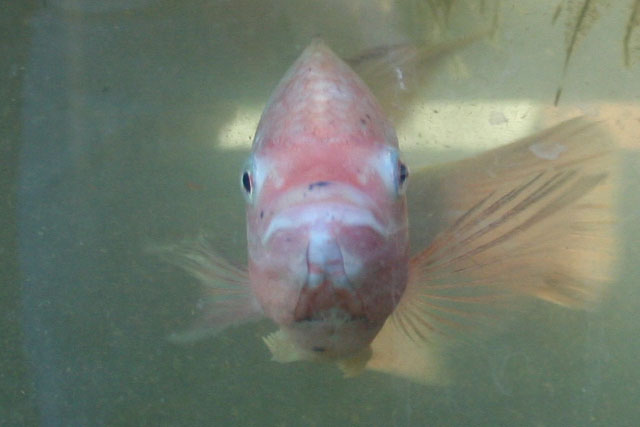
Tilapia (/tɪˈlɑːpiə/ ti-lah-pee-ə) is the common name for over a hundred species of cichlid fish from the tilapiine cichlid tribe.
Tilapia inhabit a variety of fresh water habitats including shallow streams, ponds, rivers and lakes. In the Past they have been of major importance in artisan fishing in Africa and the Levant and are of increasing importance in aquaculture.
Tilapia is a popular food fish and many species can easily be cultivated in ponds. It has been an important source of protein Africa and the Levant for thousands of years and the Ancient Egyptians cultivated tilapia in ponds along the Nile. The fish even has its very own hieroglyph.

Today, tilapia is a popular food fish all over the world and it is also kept in aquariums. Two of the most popular species among aquarists are Zebra tilapia / Tiger tilapia (Tilapia buttikoferi) and Spotted tilapia (Tilapia mariae). When it comes to tilapia farming, species such as Nile tilapia (Oreochromis niloticus) and Mozambique tilapia (Oreochromis mossambicus) are appreciated since they grow fast and refrain from breeding until they are comparatively old.
The Blue tilapia (Oreochromis aureus) is also commonly cultivated by farmers since it is one of the most cold tolerant species of tilapia. Wami tilapia (Oreochromis urolepis hornorum) is a good choice for farmers that wish to utilize brackish environments since it is salt tolerant.
The traditional way of farming tilapia is in ponds where the fish can make use of naturally occurring food. In many parts of the world, farm animals such as chicken and pigs are raised in conjunction with the fish ponds since their manure can be used to make the pond more rich in tilapia food. During the 20th century, two new methods for farming tilapia developed: tank farming and cage farming. All three types of farming come with their own pros and cons which you can read more about on this site.
In order to make tilapia fish more suitable for farming and more attractive on the food market, many different hybrids and strains have been developed by tilapia breeders. Today, you can for instance purchase red tilapia fish in the grocery store and farmers can avoid uncontrolled tilapia reproduction in their growing units by purchasing all-male batches of fry. Interestingly enough, hybridization between certain species and certain strains leads to a really skewed sex ratio in tilapia.
Since tilapia is such a popular food fish it has been introduced to many different parts of the world and is now found in the wild on all continents except Antarctica.
Sometimes it has been deliberately introduced as food fish to lakes and other bodies of water, sometimes fish have managed to escape from fish farms. Tilapia has also been introduced in order to combat mosquitoes and aquatic weeds. Since many tilapia species are highly adaptable it is easy for them to thrive in their new homes and tilapia have become a problematic invasive species in several countries.




Leave a Reply